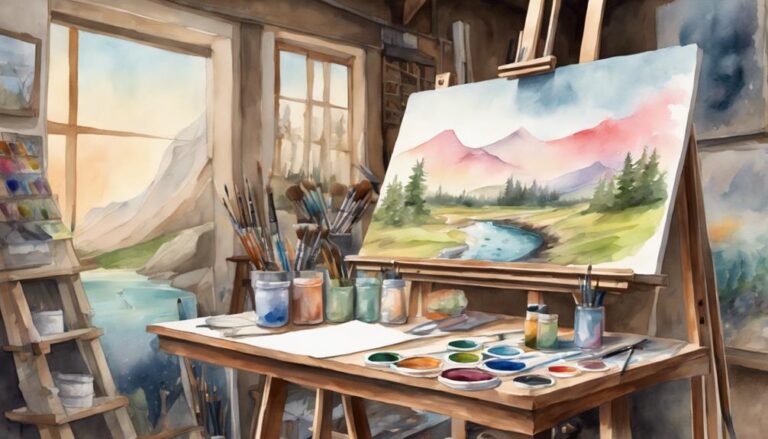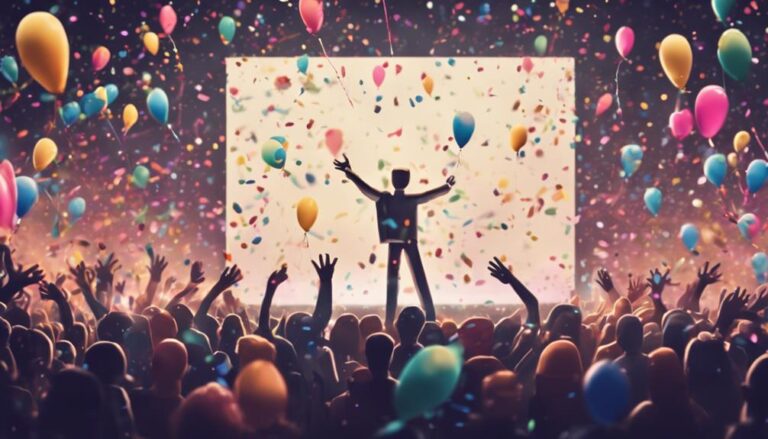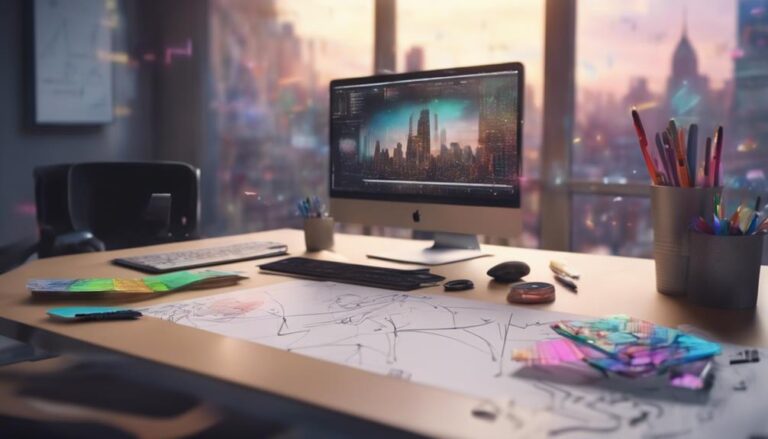10 Blender Tips for Animation Visual Development
You'll want to master Blender's interface navigation to work efficiently. Familiarize yourself with the default workspace layout and customize it to suit your needs. Understanding how to optimize performance, geometry, and textures will also help you create smoother animations. When building assets, establish a clear organization system and use Blender's Asset Browser to import and manage your files. Effective material and texture creation, along with efficient model topology and physics simulations, will elevate your visual development. By fine-tuning these aspects, you'll be well on your way to creating high-quality animations – and there's even more to explore.
Key Takeaways
- Familiarize yourself with Blender's default workspace layout for efficient animation workflow.
- Master material properties to create photorealistic animations, including diffuse color and specular color.
- Optimize geometry by reducing polygon counts or using level of detail techniques for better performance.
- Use volumetric fog effects to simulate realistic environments and add depth to your animations.
- Establish a well-structured folder organization system for efficient asset management in Blender.
Mastering Blender's Interface Navigation
Mastering Blender's interface is crucial for efficient animation workflow.
You'll spend most of your time interacting with the interface, so it's essential to learn the layout and navigation.
Familiarize yourself with the default workspace layout, which includes the Outliner, Properties, and 3D View.
As you work, you'll find that customizing the layout to suit your needs is beneficial.
Blender offers a vast array of Interface Shortcuts that can significantly speed up your workflow.
You can access these shortcuts by pressing 'Ctrl + /' on Windows or 'Cmd + /' on Mac.
Take some time to browse through the list and practice using the ones you find most useful.
Creating Custom Workspaces is another way to streamline your workflow.
You can create multiple workspaces for different tasks, such as modeling, texturing, or animation.
This feature allows you to quickly switch between tasks and maintain a clutter-free workspace.
Optimizing Performance for Animation
You've mastered Blender's interface navigation and optimized your workflow with shortcuts and custom workspaces.
Now, it's time to focus on optimizing performance for animation. This step is crucial in ensuring that your animations run smoothly and efficiently.
To achieve this, you'll need to identify performance bottlenecks in your scenes. Start by running animation tests to pinpoint areas that are causing slowdowns.
You can use Blender's built-in profiling tools to analyze your scenes and identify performance-hungry assets, such as complex geometry or high-resolution textures.
Once you've identified the performance bottlenecks, you can start optimizing them. Optimize your geometry by reducing polygon counts or using level of detail (LOD) techniques.
You can also optimize your textures by reducing their resolution or using texture atlasing.
Additionally, consider using proxy objects or simplified models to improve performance during animation playback.
By addressing these performance bottlenecks, you can ensure that your animations run smoothly and efficiently, allowing you to focus on the creative aspects of your project.
Regularly testing and optimizing your scenes will help you maintain a high level of performance throughout your animation project.
Creating Custom Asset Libraries
You can streamline your animation workflow by creating custom asset libraries in Blender.
When setting up your library, you'll need to decide on an asset organization method that works for you, such as categorizing by object type or project.
Asset Organization Methods
Your Blender projects can quickly become cluttered and disorganized if assets aren't properly managed. To avoid this, establish a well-structured folder organization system. Create a top-level folder for your project, and within it, create subfolders for different asset types, such as characters, environments, and props. This will help you quickly locate specific assets and reduce clutter.
| Folder Structure | Description |
|---|---|
| Project | Top-level folder for your project |
| Assets | Folder for all project assets |
| Assets/Characters | Folder for character assets |
| Assets/Environments | Folder for environment assets |
When naming files, use a descriptive and consistent naming convention. Include the asset type, name, and version number. This will help you identify files at a glance and avoid confusion.
In addition to a clear folder structure and file naming convention, consider using tags or metadata to further categorize your assets. This will enable you to filter and search for specific assets, making it easier to manage your library. By implementing these asset organization methods, you'll be able to efficiently manage your Blender projects and focus on the creative process.
Building Asset Templates
To build asset templates, establish a clear understanding of the types of assets you'll be working with.
Identify common objects, such as characters, props, and environments, and create base templates for each. Ensure template consistency by defining a standard naming convention, scale, and unit system.
Develop a modular approach to asset creation, breaking down complex objects into smaller, reusable components.
This will enable you to easily swap out or modify individual parts, reducing the need for redundant modeling and texturing.
When creating templates, consider the intended use case and include relevant metadata, such as materials, physics properties, and animation constraints.
Library Management Tools
Start by organizing your file systems to reflect your project's structure.
This will make it easier to find and access the assets you need. Use project templates to create a standardized structure for your projects, ensuring that all necessary folders and subfolders are included.
Blender's Asset Browser allows you to import and manage assets from your file system, making it easy to create a custom asset library.
You can import entire folders or select individual assets to add to your library. The Asset Browser also provides search and filtering capabilities, making it easy to find specific assets.
Understanding Material and Texture
Mastering the art of materials and textures is crucial in creating photorealistic animations.
When you understand how to work with materials and textures in Blender, you can take your animation to the next level. Material properties are a key aspect of creating realistic materials.
You can adjust properties such as diffuse color, specular color, and transparency to create complex and realistic materials.
To achieve realistic textures, you'll need to use texture painting. Blender's texture painting tool allows you to paint textures directly onto your 3D models.
- UV Unwrap your model: Before you can paint textures, you'll need to unwrap your model. This will create a 2D representation of your model that you can paint on.
- Choose the right brush: Blender's texture painting tool comes with a variety of brushes. Choose a brush that's suitable for the texture you're trying to create.
- Work in layers: Working in layers will allow you to organize your textures and make adjustments as needed.
Building Efficient Model Topology
| Topology Feature | Description | Best Practices |
|---|---|---|
| Quad Dominance | A mesh composed mainly of quads (4-sided polygons) | Aim for 80% or more quads for a stable and efficient mesh |
| Edge Flow | The flow of edges on the mesh that defines its shape | Use edge flow to guide deformation and rigging |
| Vertex Count | The number of vertices in the mesh | Optimize vertex count for performance, aiming for the minimum required |
| Loop Cuts | Cuts made in the mesh to create or separate loops | Use loop cuts to create or separate loops, rather than relying on individual vertex manipulation |
| Non-Manifold Geometry | Overlapping or intersecting parts of the mesh | Avoid non-manifold geometry to prevent rendering issues and performance problems |
Advanced Lighting Techniques
When animating complex scenes in Blender, you'll often need to create realistic lighting effects that add depth and atmosphere.
To achieve this, you can use volumetric fog effects to simulate the way light interacts with particles in the air, creating a sense of mist or haze.
Volumetric Fog Effects
To achieve realistic environments in your Blender animations, you'll often find yourself working with volumetric fog effects.
This advanced lighting technique allows you to create immersive and atmospheric scenes by simulating the way light interacts with fog.
When working with volumetric fog, it's essential to balance the Fog Density and Fog Behavior to achieve the desired effect. Fog Density controls the thickness and opacity of the fog, while Fog Behavior determines how the fog interacts with light.
You can adjust these settings to create a range of effects, from subtle mist to dense, eerie fog.
Some key considerations when working with volumetric fog effects include:
- Fog Volume: Use a 3D volume to define the area where the fog is visible, allowing for more precise control over the effect.
- Lighting: Adjust the lighting settings to balance the intensity and color of the fog, creating a more realistic and immersive environment.
- Depth: Experiment with different depth settings to create a sense of distance and atmosphere in your scene.
Realistic Ambient Occlusion
Achieving realistic environments in your Blender animations often involves a combination of advanced lighting techniques, including volumetric fog effects, which we just covered.
However, to take your scenes to the next level, you'll need to incorporate realistic ambient occlusion. Ambient occlusion is a technique that simulates the way ambient light interacts with objects in your scene.
It adds depth and dimensionality by creating subtle shadows in areas where objects meet or are close to each other.
In Blender, you can achieve realistic ambient occlusion using various Occlusion Methods, such as Screen Space Ambient Occlusion (SSAO) and Ambient Occlusion (AO) maps.
SSAO is a fast and efficient method that works well for most scenes, while AO maps provide more detailed and accurate results.
When using AO maps, you can adjust settings like radius, samples, and intensity to fine-tune the ambient details.
Experimenting with different Occlusion Methods and settings will help you achieve the desired look for your animation.
Using Physics and Simulations
Working with complex scenes, physics and simulations can greatly enhance your Blender animations, adding realism and depth to your projects.
By using the Rigid Body physics system, you can simulate realistic collisions and interactions between objects, making your scenes feel more dynamic and immersive.
To take your simulations to the next level, you can also utilize Soft Simulations, which allow you to create realistic deformations and movements for fabrics, hair, and other soft objects.
This can be especially useful for creating realistic character animations and interactions.
Some key things to keep in mind when working with physics and simulations in Blender include:
- *Use the right solver for the job*: Blender offers a range of physics solvers, each with its own strengths and weaknesses. Make sure to choose the one that best fits your needs.
- *Tweak your simulation settings*: Experiment with different settings to get the look and feel you want.
This can include adjusting the solver's iteration count, collision margin, and more.
* *Use caching to improve performance*: Caching your simulations can help improve performance and reduce rendering times.
Creating Realistic Animation Cycles
When creating realistic animation cycles in Blender, you'll focus on perfecting keyframe animation techniques to capture nuanced character movements.
To achieve seamless motion, you'll also need to master looping animation essentials, ensuring your cycles blend together flawlessly.
Keyframe Animation Techniques
Keyframe animation techniques are the backbone of creating realistic animation cycles in Blender.
As you work on developing your animation skills, mastering keyframe techniques will allow you to achieve the desired level of realism and polish.
To create realistic animation cycles, you'll need to pay attention to motion paths.
A well-planned motion path can make all the difference in creating a believable animation.
Breakdown tutorials can be a great resource to learn from others who've successfully achieved this.
- Use the Graph Editor to fine-tune the animation curve and achieve a more natural motion.
- Experiment with different easing options to add a touch of realism to your animation.
- Use the Dope Sheet to manage and organize your keyframes, making it easier to adjust and refine your animation.
Looping Animation Essentials
A well-crafted animation cycle relies heavily on seamless looping transitions.
To create realistic cycles, you'll need to understand the fundamentals of looping animation. First, ensure your animation is set to the correct frame rate. Common frame rates include 24, 30, and 60 frames per second. Choose a frame rate that suits your project's needs.
When creating a loop, it's essential to follow the 12 basic principles of animation. These principles, developed by the Disney animators Ollie Johnston and Frank Thomas, include squash and stretch, anticipation, staging, and timing.
By applying these principles, you'll create a believable and engaging animation cycle.
To achieve a seamless loop, you'll want to match the first and last frame of your animation. You can do this by duplicating the first frame and placing it at the end of your animation.
Then, adjust the timing and spacing of your animation to create a smooth transition between the two frames.
Timing and Pacing
Timing and Pacing
======================
Most animation cycles rely heavily on effective timing and pacing to create a believable and engaging experience.
When creating realistic animation cycles in Blender, it's essential to consider the timing and pacing of your animation flow. This will help you create an immersive experience that captures the viewer's attention and evokes the desired emotional response.
To achieve this, you should focus on creating a clear and consistent animation flow that takes into account the emotional beats of your scene.
Emotional beats are the moments that evoke a specific emotional response from the viewer. By carefully timing and pacing your animation, you can create a more engaging and believable experience.
Some key considerations for timing and pacing include:
- Experiment with different timing: Try out different timing options to see what works best for your scene.
- Use reference footage: Use reference footage to get a sense of the timing and pacing of real-life movements.
- Pay attention to spacing: Make sure to pay attention to the spacing between keyframes to create a smooth and believable animation flow.
Streamlining Your Workflow Process
Streamlining your workflow process in Blender can significantly boost your animation productivity. By simplifying your workflow, you can save time and focus on perfecting your craft. Workflow simplification involves identifying repetitive tasks and finding ways to automate them.
| Task | Automation Method |
|---|---|
| Rigging | Use the Rigify add-on to speed up the rigging process |
| Animation Cleanup | Use the Graph Editor to clean up keyframes and optimize motion curves |
| File Management | Use Blender's built-in file management tools to organize your project files and assets |
Task automation is another crucial aspect of workflow simplification. By automating repetitive tasks, you can free up time to focus on more creative aspects of your animation. Blender provides a range of tools and add-ons that can help you automate tasks, from rigging and animation cleanup to file management. By streamlining your workflow and automating tasks, you can work more efficiently and effectively, producing high-quality animations in less time.
Rendering for High-Quality Output
While fine-tuning your animation, you're likely eager to showcase your work with stunning visuals, which is where rendering for high-quality output comes in.
To achieve this, you'll need to pay attention to several key factors in Blender.
- Set an optimal image resolution: A higher resolution will result in a more detailed image but will also increase render times.
- Adjust your color grading: This can greatly impact the mood and atmosphere of your animation.
- Use the right render engine: Blender's Cycles render engine is capable of producing high-quality images with advanced features like path tracing and volumetrics.
When rendering for high-quality output, it's essential to consider the balance between image quality and render time.
You can experiment with different rendering settings and techniques to find the optimal balance for your project.
Additionally, using features like render layers and compositing can help you fine-tune your image and achieve the desired look.
Frequently Asked Questions
Can Blender Handle Large-Scale Architecture Projects?
When handling large-scale architecture projects, you can manage complex city planning and building information by utilizing Blender's robust tools, including data linking and modifiers, to efficiently create and manipulate massive 3D models and scenes.
Is Blender Compatible With Other 3D Modeling Software?
You can import files from other 3D modeling software into Blender through File Import, supporting formats like OBJ, FBX, and STL. This facilitates Software Integration, allowing you to work seamlessly with multiple programs and workflows.
How to Transfer Blender Skills to Other Animation Tools?
You'll find that mastering keyframe animation, texture painting, and lighting techniques boosts your cross-platform skill portability. By focusing on fundamental concepts, you'll easily adapt to other animation tools and software, leveraging your existing expertise efficiently.
Can Blender Be Used for Virtual Reality Projects?
You can leverage Blender for virtual reality projects, focusing on VR storytelling and crafting immersive experiences. Exporting models, textures, and animations to VR platforms is feasible, allowing you to create engaging, interactive environments and narratives.
Is Blender Suitable for Creating Video Game Assets?
You can use Blender to create game assets due to its PBR materials and real-time rendering capabilities, making it suitable for game development. It supports popular formats and has a physics-based rendering engine.
Conclusion
You've now grasped essential techniques for animation visual development in Blender. By optimizing performance, creating custom asset libraries, and mastering model topology, you'll streamline your workflow. Understanding materials, textures, and physics simulations will elevate your animations. Efficient rendering techniques will deliver high-quality output. Apply these skills to refine your craft and tackle complex projects with confidence, unlocking new creative possibilities in the world of 3D animation.







